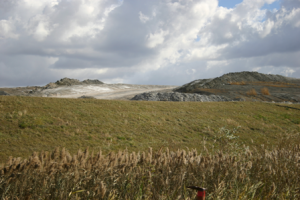When a new coal mine breaks ground, the door is opened for the coal company to dump toxic coal slurry and coal ash in central Illinois communities.
Coal Slurry Impoundments
Coal mines use roughly 2 million gallons of water daily to wash coal when it comes out of the ground. Coal slurry is the contaminated process water that is leftover. It contains elevated levels of chlorides, sulfates, arsenic, lead, mercury, and selenium.
Coal companies dispose of coal slurry in massive impoundments. Coal slurry impoundments represent a major threat to public health andaquatic organisms due to potential contamination of groundwater and streams. Additionally they pose a serious safety hazard.
When the impoundments are full, the slurry pile is “reclaimed” by draining off the water and covering the pile of slurry solids with clay and dirt. After the coal mine is gone, rural communities can be left with massive piles of pollution. The final height of Deer Run Mine’s reclaimed refuse disposal area is projected to be nearly 100 feet tall.
Coal Ash
At coal mines in central Illinois, coal ash (the solid byproduct leftover after coal is burned to generate electricity) is often dumped into unlined slurry impoundments at coal mines or held in similar impoundments near coal burning power plants. Harmful metals are concentrated when coal is burned, so coal ash contains elevated levels of arsenic, mercury, selenium, chromium and cadmium. Currently, coal ash dumps are subjected to less regulation than household garbage, even though coal ash is known to contain extremely harmful pollution.
Coal ash impoundments pose a serious threat to public health and safety, as illustrated by the TVA Kingston Fossil Valley Coal Ash Spill in 2008. There are at least 83 such coal ash impoundments in Illinois, and at least a dozen are known to have contaminated groundwater.
At the Crown III Mine in Macoupin and Montgomery Counties near Farmersville, Illinois, coal ash and slurry are dumped in the same unlined impoundment. Crown III is authorized to accept coal ash from 37 different sources, illustrating a worrisome trend in Illinois where coal burning facilities pay to dispose of the coal ash at the mine where the coal originated. At a public hearing for Crown III’s water pollution permit renewal in December 2010, Illinois EPA admitted that groundwater monitoring wells on the site were violating water quality standards. It is urgent that Illinois EPA stop allowing coal mines to dispose of coal waste in ways that threaten clean drinking water.


